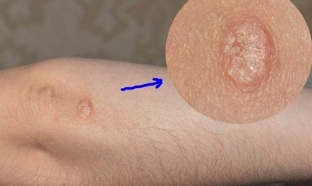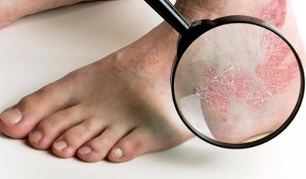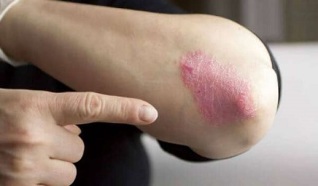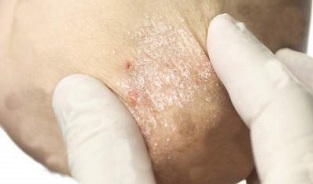Pearl is an inflammatory skin disease. Occurs when the immune system is compromised. The development of the disease is divided into clear stages - appearance, development, stabilization and regression. Different stages of psoriasis are characterized by the appearance of spots and rashes, itchy pain and extensive skin inflammation.
Why is it necessary to distinguish the stages of development of the disease, and what are the features of the course of psoriasis at the beginning of development and recovery?
Why you need to know the stages of psoriasis

The division of psoriasis into stages is used by doctors to select the right therapeutic methods. The complex of drugs and external agents prescribed for the treatment of inflammation depends on the stage of development of the disease.
At the beginning of the manifestation of the disease requires general therapy - vitamin complexes, diet, external aseptic treatment of rashes, for example, a course of UV procedures. Also drugs that stimulate the cleansing of the intestines, blood vessels and liver.
Be sure to have your psycho-emotional condition corrected by a neurologist or psychologist.
In the early stages of the disease do not use strong drugs that suppress the immune system, do not prescribe hormonal ointments. These drugs have a long list of side effects, so they are prescribed only when it is impossible to do without them.
Psoriasis: treatment in acute and remission
In case of acute progression of the disease, several drugs with different actions are prescribed. Immunosuppressants and glucocorticosteroids are often used to relieve inflammation and reduce itching. External treatment is complemented by photochemical, ultrasound and laser therapy. Also prescribed agents for antiseptic treatment of damaged skin.
In a stable state, they continue to take hormonal anti-inflammatory drugs, gradually reducing their dose. Ointments with a restorative effect are prescribed to repair damaged skin.
In remission - support the body. Adjust your diet, take vitamin and mineral complexes to restore immunity.
Timely treatment
The earlier treatment is started, the easier it is to control psoriasis.

Timely therapy limits the spread of skin inflammation, reduces the degree and prevents further peeling. Since psoriasis is often mistaken for an allergic rash in the early stages, it is important to know the first signs so as not to miss the appearance of a skin disease.
Note:Doctors are still investigating the causes of psoriasis. However, it is well known that psoriatic inflammation of the skin is not contagious. The patient cannot be taken from a person or there can be an infection in case of injury. This is our own personal failure in the human body.
The cause of psoriasis is an immune deficiency that can be caused by a variety of factors. Severe stress, poisoning (including strong drugs, industrial emissions, alcohol), previous infection.
Psoriasis is difficult to treat. The disease is prone to recurrence and relapse. And the therapy itself is symptomatic. This is to prevent the formation of new spots and eliminate existing skin itching.
What stage of psoriasis is called primary? How to distinguish early psoriasis from diathesis rash? And how will the disease develop in the future?
Psoriasis: early stage
The first appearance of psoriasis on the skin is similar to acne. The rash often appears on your elbows and knees, or where clothing is pressed tightly against your body (for example, under the waistband). Rash can also appear on the edges of the hair and under the hair, around the nails and on the nail plates. Sometimes psoriasis occurs on the feet and palms.
Psoriasis almost always manifests itself symmetrically - on the elbows of both hands or on both sides of the waist or on both knees.
At first, the pimples themselves (in medical terminology - papules) have a modest appearance. These are:
- pink or red;
- Sharp, blurred edge;
- Small - acne on the bottom is not more than two millimeters;
- Flat form - small pimples at the beginning of the disease have almost no puffiness, so they look like spots.
As the disease progresses, peels appear on the skin. They are gray or silver, they look white against a red acne background.
The appearance of scales is accompanied by a very severe itching. If you do not resist and do not scratch, the scales are removed and the bright pink areas of the young skin underneath are opened. It is very delicate, sensitive, with prolonged scratching of itchy papules - bruises, bleeding.
The initial stage of psoriasis lasts up to four weeks.
Psoriasis: stage of development

In the progressive stage, individual pimples combine into a common spot to form so-called psoriatic plaques. It is lifted above the surface of the skin and almost completely covered with peeling. The edges of the psoriatic plaques have a non-peeling pink-red edge.
The presence of a border is a sign of a progressive stage of the disease. The width of the rim is one to two millimeters. The skin is inflamed, the structure resembles parchment paper.
The rim represents the expansion area of the stain. This is already inflamed skin, but not yet peeled. After a while it will be covered with scales. And the patch will expand to cover new areas of skin and create a wider edge.
With the active development of the disease, the adjacent spots merge with each other. At some point, a large, inflamed red spot may appear on the human body.
Psoriatic plaques itch a lot, make people feel uncomfortable, disturb their work, rest and sleep. They grow, cover a large area and form a new rash on clean, healthy skin.
The main sign of a progressive stage is the appearance of new rashes. As new pimples and blemishes stop appearing, the next stage of psoriasis begins - stationary. This is not a complete victory, but it is a turning point for recovery.
In the stage of progression, psoriasis is almost always accompanied by weakness, fatigue, weakness. Depression is common. Heating is possible.
Note:Some medical theories say the opposite. Depression is not a consequence of psoriasis. Psoriasis is a result of neurology, depressive psyche.
The advanced stage of psoriasis can be long, several months.
Pearl: stationary stage

The main symptom of the stationary phase is the cessation of new spots and rashes. At the same time, itching is reduced, it becomes more tolerable. The rash loses its bright color, changes color, becomes invisible. This is also one of the signs of stabilization of the process.
The pink bands around the plaques disappear when the inflammation stops spreading. Active exfoliation and healing begins, restoring new healthy skin.
Increased peeling in the stationary phase is noticeable to the naked eye. The scales completely cover the entire surface of the psoriatic spot and leave no space on the rims.
Psoriasis takes on the appearance of characteristic scales, widely known. Extensive peeling at the stationary stage is not dangerous.
When all the dead cells leave the surface of the psoriasis spot, they will remain in healthy skin areas with a light shade.
Other signs of development or stabilization
In addition to the appearance of rash, blemishes, and scaling, there are a number of other signs that can be used to assess the progression of the disease. This is the nature of the itching sensations (strong or tolerable), the general condition, the depressive mood. Both the presence of heat.
At the initial stage, itching is variable and the rash is incomprehensible. In addition, the itching gets worse every day. In the acute stage of psoriasis becomes unbearable. Disrupts sleep, rests, interferes with work. Itching makes a person nervous because it does not allow him to rest.
Itching is reduced in the stationary stage. Every day - a person feels better. The general state of the psyche changes, the negative and depressive mood weakens. The duration of the inpatient phase is several weeks - between 2 and 5.
Psoriasis in the debilitating phase

The fading stage of psoriasis is the almost complete disappearance of plaques, spots, redness, inflammation, itching.
At this stage of the disease, psoriasis is just reminiscent of different skin pigmentation. Former psoriatic spots appear lighter in place. There is a darker shade on the surface of healthy skin.
In some cases, the so-called hyperpigmentation occurs. The skin at the site of psoriasis spots is not lighter, but darker. In any case, the differences in skin pigmentation will be visible for another month or two.
Psoriasis after recovery: the possibility of relapse
The likelihood of recurrence of psoriasis is determined by a person's lifestyle, diet, allergic mood and the condition of the body as a whole. It is also determined by the amount of toxins in the body, blood and liver. If you strengthen your immune system and cleanse the body of toxins in the liver, blood vessels and intestines, you can reduce the likelihood of recurrent skin inflammation.
Seasonal relapses of psoriasis are rare after cleansing. A person remains susceptible to disease, but the likelihood of its occurrence is significantly reduced.
Cleansing the body of toxins and taking vitamin and mineral complexes helps increase immunity. This is especially important during treatment when immunosuppressants are used in the progressive phase of psoriasis. Their need was related to the work of inflammatory mediators. After suppressing the autoimmune defense, the immune system needs to be restored.
























